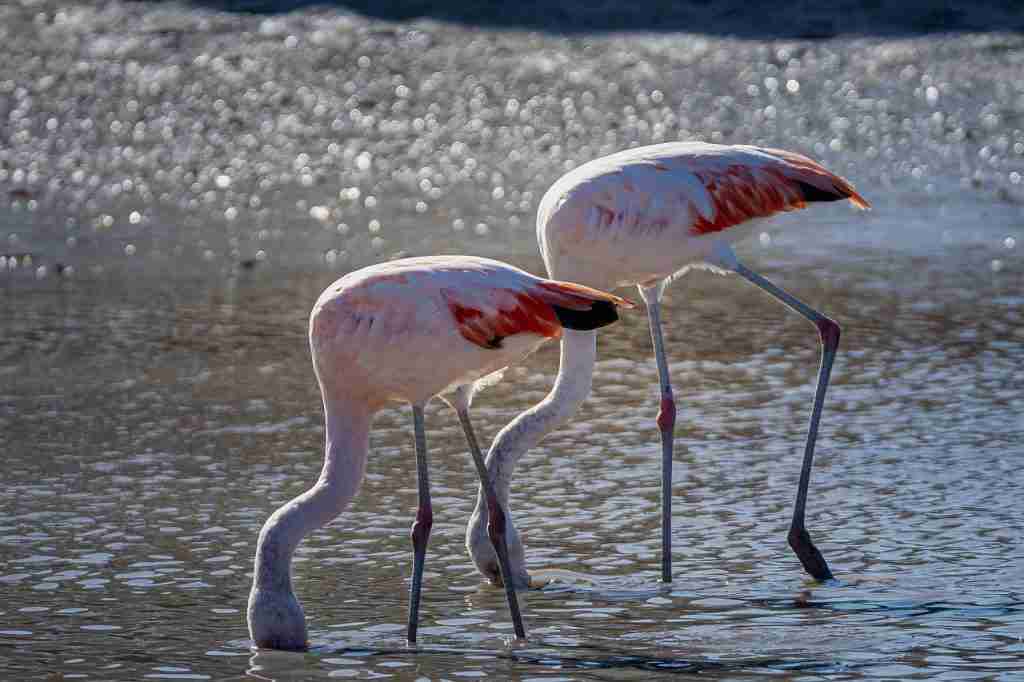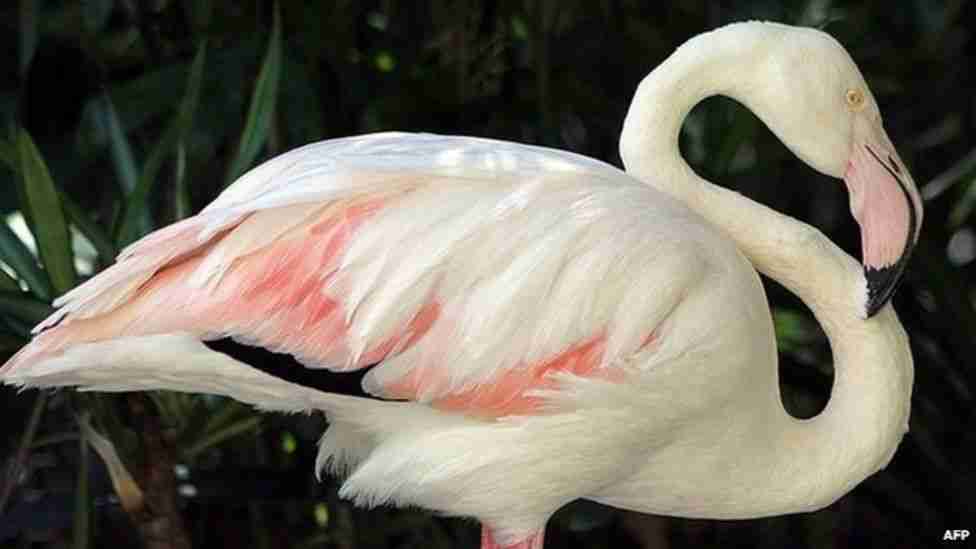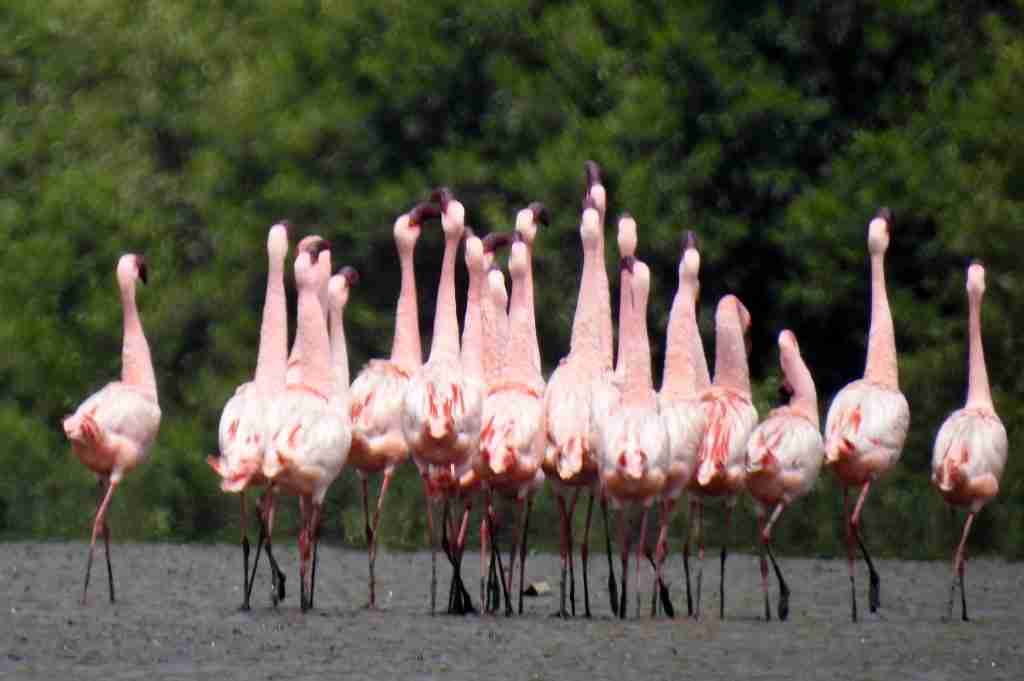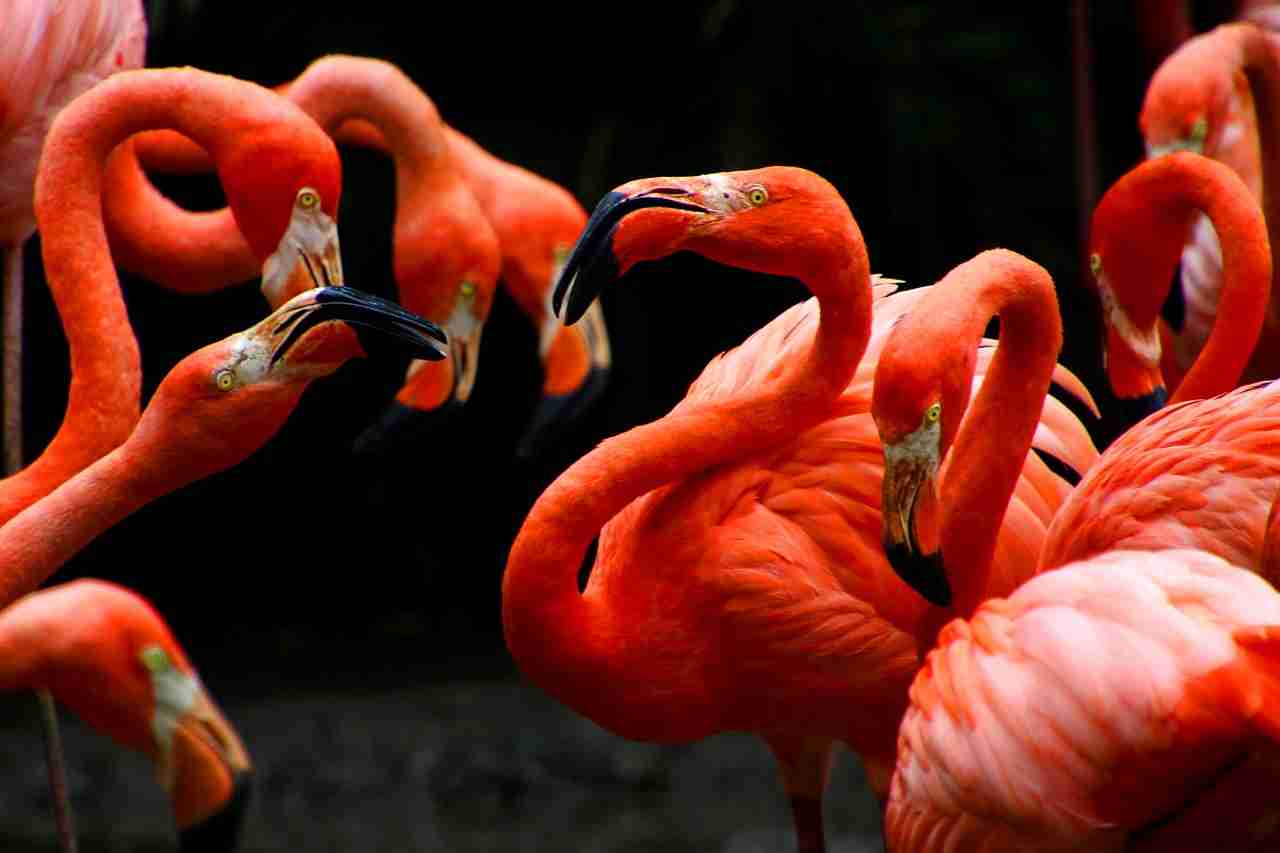25 Fun Facts About Flamingos | Feathered Pink Wonders
1. Flamingos can live in waters hotter than 150°F and twice as salty as oceans.
Flamingos are remarkable, living in extreme conditions from scorching 150°F waters to frigid -22°F nights. They adapt to both fresh and super salty waters, filtering out salt with a special gland.
Their bodies are fine-tuned to handle temperatures from 64°F to 95°F. Amazingly, they even thrive in corrosive soda lakes, a habitat too harsh for most.
2. Flamingos are not naturally pink; they get their color from their diet.
Flamingos aren’t born pink; their diet of algae and shrimp, rich in carotenoids, colors their feathers. These pigments, also in carrots and tomatoes, turn young grey flamingos pink.
Without these foods, flamingos would turn white. Their unique diet, toxic to many animals, includes brine shrimp and algae, essential for maintaining their vibrant hue.
3. Flamingos can live up to 30 years in the wild and 70 years in captivity.
Flamingos can live up to 30 years in the wild and 70 years in captivity. In the wild, their lifespan typically ranges from 20 to 30 years, with some reaching 50.
However, in zoos, flamingos often live longer, usually between 50 to 70 years. This longevity makes them one of the longest-lived bird species, both in the wild and in captivity.
4. Flamingos can sleep standing on one leg.

Flamingos can sleep while standing on one leg, thanks to special leg ligaments that lock in place, reducing muscle effort. This posture might help them conserve energy and react quickly to danger.
It’s also thought to maintain body warmth, as they lose less heat with one leg tucked in. Research shows they prefer this stance in cooler temperatures, switching to two legs when warmer.
5. One in 300 people experience Phoenicopterus phobia, a fear of Flamingos.
Phoenicopterus phobia, the fear of flamingos, affects 1 in 300 people. Many find their red or yellow eyes with tiny black pupils unsettling. Their thin, mechanical-like legs also contribute to this fear.
While cartoon flamingos appear cute and fluffy, the real birds‘ piercing eyes and unusual body shapes can seem intimidating to those with this specific phobia.
6. Flamingo eggs sometimes have pink yolks.
Flamingo egg yolks can sometimes be pink, though they’re usually red or orange like chicken eggs. This pink tint happens if their diet is rich in certain pink microbes.
Generally, flamingo eggs resemble chicken eggs, with white shells and yellowish or reddish yolks. But in unique cases, their yolks take on a distinct pinkish color, reflecting their unique diet.
7. Pink Flamingo Day is observed every year on June 23.
Pink Flamingo Day, celebrated on June 23, honors the iconic lawn ornament and its creator, Don Featherstone. Introduced in 1957, these plastic flamingos were initially admired but later seen as tacky.
Despite public opinion, Featherstone proudly signed his creations in 1987. He was awarded the Ig Nobel Arts Prize in 1996, a day before he died in 2015. Dean Mazzaralla created this day in 2007.
8. Flamingos feed with their heads upside down to filter food from water.

Flamingos feed uniquely: they dip their heads upside down in water, using their beaks and tongues like sieves. They scoop up water and food, then skillfully push the water out while trapping algae and tiny crustaceans inside their beaks.
This upside-down feeding technique is a clever adaptation to efficiently gather their food from the water.
9. Flamingos live in large groups, sometimes consisting of thousands of birds.
Flamingos are highly social birds, living in large colonies that can range from a few pairs to thousands. These massive groups help them avoid predators, find food more efficiently, and use nesting sites effectively.
Typically, before breeding, these colonies divide into smaller groups of 15 to 50 birds, demonstrating their complex social structure and communal living habits.
10. Flamingos congregate around mudflats in lagoons for shallow saltwater prey.
Flamingos gather in mudflats and lagoons, ideal for finding shallow saltwater prey. Their beaks are perfectly adapted to sift animals from the mud, stirred up by their feet.
These habitats, challenging for predators, offer flamingos a safer environment to feed and live. This preference for mudflats and lagoons showcases their specialized feeding habits and natural adaptation for survival.
11. Female Flamingos are monogamous and lay one egg per year.
Female flamingos, monogamous by nature, lay just one egg annually. They breed within their colony, timing mating with rainfall, crucial for nest building and food availability.
At around six years old, they start mating and constructing nests from sticks, stones, mud, and feathers. This six-week process culminates in egg-laying, followed by a month-long wait for the chick to hatch.
12. Flamingos feed their chicks with ‘crop milk’ from their throat.
Flamingo parents feed their chicks with ‘crop milk,’ a high-fat, high-protein substance produced in their throat. This unique milk, rich in lipids and proteins, is secreted from the crop’s lining, a part of the digestive tract.
Both male and female flamingos produce this milk, stimulated by the hormone prolactin, similar to mammals. Over time, chicks transition from crop milk to a regular adult diet.
13. Flamingos are capable flyers and often migrate at night.
Flamingos, capable of high-altitude flight, often migrate at night, covering distances up to 350 miles. They fly mainly due to changing habitats, influenced by climate, water levels, and breeding needs.
Preferring cloudless skies, they can soar between 10,000 to 15,000 feet. While not their primary mode of movement, their flight ability is crucial for seasonal migrations, especially heading south in winter.
14. The Lesser Flamingo has the highest population among Flamingo species.
The Lesser Flamingo, the smallest of its kind, boasts the largest population among flamingo species around the world.
Predominantly found in sub-Saharan Africa and western India, this species, scientifically known as Phoeniconaias minor, has an impressive estimated global population ranging from 2.2 to 3.2 million.
15. Flamingos have hollow bones, aiding in flight despite their size.
Flamingos, often less than 10 pounds, manage to fly thanks to their hollow bones. These bones, while aiding in flight, also pose a challenge in keeping warm in cold waters.
This lightweight structure is essential for their versatility, allowing them to walk on land, soar in the sky, and swim in the water, easily adapting to various environments.
16. The Flamingo’s leg bend is actually its ankle, not its knee.
The bend in a flamingo’s leg is its ankle, not the knee, which is hidden inside its body. This unique structure, including a ‘stay apparatus’ in the ankle, allows flamingos to balance effortlessly on one leg.
When they bend this joint, other joints align, and gravity helps them stay upright. Their actual knees are concealed by feathers, higher up near their bodies.
17. Flamingos have 19 bones in their neck.
Flamingos possess 19 bones in their necks, granting them exceptional flexibility. This adaptability is crucial for survival, enabling them to easily reach food at the bottom of ponds and lakes.
By flipping their heads upside down, they scoop up algae and small creatures, filtering out excess water with specialized structures in their bills. This flexibility also aids in grooming and reaching their feathers.
18. The Flamingo is the national bird of The Bahamas.
The Flamingo, specifically the Caribbean variety, is the national bird of The Bahamas. Key conservation efforts in The Bahamas, notably in Inagua, played a crucial role in preventing their extinction.
Thanks to these initiatives, including the formation of the Society for the Protection of Flamingoes and the Bahamas National Trust, over 50,000 flamingoes now thrive in the region.
19. Both male and female Flamingos incubate the egg and feed the chick.
Flamingos, forming strong pairs, build mud mound nests by water. Both males and females take turns incubating their single egg in these nests. After about 30 days, the egg hatches.
Post-hatching, both parents feed the chick with ‘crop milk,’ a special nutrient-rich substance. This shared parenting approach, from egg incubation to chick feeding, highlights the cooperative nature of flamingo pairs.
20. The oldest recorded Flamingo lived to 83 years old.

The world’s oldest recorded flamingo, known as Greater, lived to 83 years. Arriving at Adelaide Zoo in 1933, Greater’s exact origin is unclear, possibly from Cairo or Hamburg Zoo.
This greater flamingo, unique for its longevity, was the last of its kind in Australia. Greater passed away in 2014 due to age-related complications, marking the end of an extraordinary life.
21. Flamingos’ ancestors were swimming birds.
Flamingos likely evolved from Junciatarus, a swimming bird species. Their ancestors, once divers, now wade in water rather than swim. This evolution occurred in the late Eocene, with flamingos and grebes diverging from a common ancestor.
While their extinct relatives had shorter legs and hunted by diving, modern flamingos have specialized in filter-feeding, a change not traced due to limited fossil records.
22. Flamingos don’t have teeth; their beaks and tongues have lamellae for filtering food.
Flamingos lack teeth but possess beaks uniquely designed for filter-feeding. Their beaks used upside-down, are equipped with sharp lamellae to separate mud and silt from food like brine shrimp.
These lamellae, along with their large, rough-surfaced tongues, efficiently filter food from water. This specialized feeding mechanism allows flamingos to sift tiny organisms from the water, adapting perfectly to their diet.
23. In ancient Rome, Flamingo tongues were a delicacy.
In ancient Rome, flamingo tongues were a prized delicacy, savored by the wealthy and high-ranking. The entire bird was a common dish, but its tongue was a luxury, symbolizing elite status.
Sometimes served as ‘Roast Fenicopterus’ at lavish dinners, flamingo meat was also a display of wealth. Today, these birds are protected, making it illegal to consume or harm them.
24. Flamingos carry out complex courtship rituals.

Flamingos have intricate courtship rituals. Studied in wild greater flamingos, these complex dances, including head flagging and wing saluting, become more elaborate with age, peaking at around 20 years.
Both males and females participate, with the brightest males often initiating. In Chilean flamingos, wing flashing even indicates interest in a specific mate, a unique aspect of their courtship behavior.
25. There are six Flamingo species worldwide.
There are six flamingo species worldwide, each unique in size and habitat. The largest, the Greater Flamingo, resides in Africa, Europe, and Asia, while the smallest, the Lesser Flamingo, lives in Africa and India.
South America is home to the Chilean, Andean, and James’s Flamingos. The American Flamingo inhabits the Caribbean, Mexico, and the Galapagos. Each species adapts to diverse environments, from high-altitude wetlands to coastal lagoons.
FAQs
Flamingos and shrimp turn pink by consuming algae rich in carotenoid pigments. Their diet includes algae and shrimp-like creatures, resulting in their vibrant pink coloration.
Flamingos stand on one leg to save energy, move quickly if needed, and stay warm in colder weather. Special leg ligaments lock in place, reducing muscle effort, while the tucked leg helps conserve heat.
Flamingos live in various habitats, including coastal lagoons, mudflats, and alkaline lakes. They can be found in regions like Africa, Europe, Asia, the Americas, and even some parts of India.
Flamingos are born in nests made of mud mounds near water. The female lays one egg in a shallow hole at the top of the mound. Both parents take turns keeping the egg warm until it hatches, which takes about 30 days.
Flamingos come from various regions worldwide. Greater flamingos inhabit parts of Africa, Asia, and Europe. In South America, you’ll find Chilean, Andean, and James’s flamingos, with Andean flamingos being the rarest, numbering fewer than 40,000.







